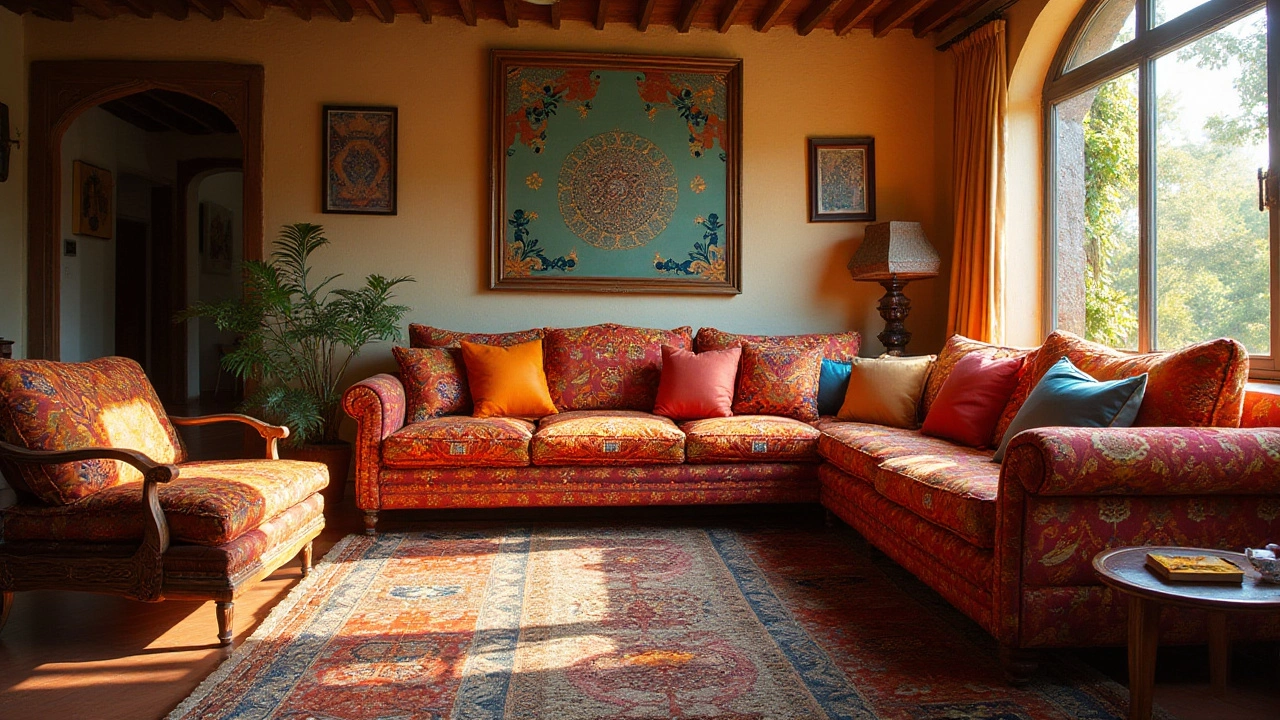Stepping into the world of sofas, one quickly realizes it's not just about selecting something to sit on. A sofa is a statement, a comfort zone, and often the centerpiece of a living room. It reflects personal style while offering the utmost comfort or practicality your household might require.
Whether you're searching for plush sanctuary or a sleek space-saving piece, finding the ideal sofa can be both rewarding and puzzling. It requires balancing factors like room dimensions, fabric issues, style coherence, and budgeting. Understanding these elements paves the way for a shopping journey that ends with the ultimate comfort and beauty in your home.
Let's delve deeper into how you can decode the complexity of sofa shopping, ensuring you invest in a piece that could very well be with you for years, if not decades.
- Understanding Sofa Dimensions
- Choosing the Right Material
- Functionality and Sofa Features
- Aligning with Your Interior Style
- Evaluating Sofa Comfort
- Budgeting and Long-term Investment
Understanding Sofa Dimensions
Shopping for a new sofa is an exciting venture, yet one of the most critical aspects often overlooked is its dimensions. The importance of size can’t be understated—it is pivotal to both the aesthetic harmony and the practical functionality of your living space. A sofa that fits perfectly in your space essentially sets the stage for everything else in your room, directing traffic flow and aligning with your personal style. Therefore, before you even start looking at colors or patterns, grab your measuring tape; this is where your journey into the world of sofas genuinely begins.
Consider the length, depth, and height of the sofa in relation to the room dimensions. Each measurement plays a pivotal role in how the piece will occupy space. Equally vital is ensuring your chosen sofa can maneuver through doorways, hallways, and staircases without a hitch. It's poignant to note that the average three-seater sofa usually measures around 84 inches wide, while a loveseat spans approximately 60 inches. Meanwhile, sectional sofas, renowned for their bulk, can exceed 100 inches; gauging these against your living area’s scale is crucial.
"The best way to optimize room layout is to ensure every piece of furniture is in harmony with its environment—not only visually but spatially," says interior designer Toma Clark Haines.
Think about how the sofa’s depth plays into comfort. Many people find that a depth of 37 to 40 inches tends to strike the right balance; enough depth to sit comfortably with the option to lounge. More importantly, a depth that suits how you naturally sit. Are you inclined to sit upright or lounge back lazily? Knowing this familiar seating stance guides you in selecting a sofa's depth that melds seamlessly with daily habits.
Height is another dimension requiring thought. The height of the back and arms can dramatically alter the feel and look of a sofa. Lower backs (sofa selection) are modern and less imposing, making a room feel airier, while higher backs may lend an element of coziness and support. A typical height ranges between 30 to 36 inches, but always remember, a taller sofa might dominate a smaller room.
Lastly, do not forget scale and proportion. A balance must be struck between your chosen sofa selection and the room's existing furnishings. Take into account the other furniture and decor, considering how the sofa's dimensions will affect interactions within the room. Use a floor plan to map out optimal arrangements or even try using tape on the floor to visualize sofa sizes. This can spare you distress and help you see your living space's potential before a single piece is moved.
Choosing the Right Material
When it comes to selecting the material for your ideal sofa, the choice can feel overwhelming. With the vast array of options available, it’s crucial to weigh both aesthetics and practicality to find something that will not only look beautiful in your space but also stand the test of time. The different types of materials come with their own set of benefits and drawbacks, and understanding these can help you make an informed decision.
Fabric sofas offer a multitude of choices, from cotton and linen to synthetic fibers like polyester and microfiber. Cotton and linen are popular due to their breathable nature and soft touch, making them comfortable for all seasons. Synthetic fabrics, on the other hand, are known for their durability and resistance to stains, making them a preferred option for families or homes with pets. A fabric like microfiber, for instance, is not only affordable but is also resistant to scratches and provides a pleasant texture.
"The choice of fabric influences the overall maintenance and appearance of your sofa," remarks Emily Henderson, a renowned interior design expert. "A well-thought fabric decision ensures your furniture complements your lifestyle efficiently."
Turning to leather, this is often seen as a classic choice, adding an element of luxury to any living room. Leather sofas are valued for their longevity and ease of cleaning, due to their spill-resistant nature. However, leather does come at a premium price, and the natural material can be susceptible to scratches without proper care. Choosing between genuine leather or an eco-friendly faux leather is another consideration, with the latter offering a more budget-friendly alternative.
Sofas made with mixed materials, combining fabrics and leather, or incorporating wood and metal elements, can offer a unique touch to your living room decor. These combination pieces often provide enhanced durability and style, allowing for personalized design variety. Whether it involves plush seating or sturdy frames, a mix of materials can cater to the varied preferences of a household.
Lastly, it’s worth considering hypoallergenic materials if anyone in the household suffers from allergies. Certain fabrics are specifically treated to resist dust mites and allergens, ensuring everyone's comfort. Evaluating what suits your needs, including room usage and lifestyle habits, will influence your ideal sofa's material choice. This decision encompasses much more than taste; it’s about harmony between your sofa and everyday life.

Functionality and Sofa Features
When venturing into the search for the perfect sofa, it's essential to weigh not only its aesthetics but also its functionality and the features it offers. This often determines whether a couch will be a fleeting fancy or a long-loved household staple. Consideration begins with your personal needs and lifestyle. If you're part of a bustling family or frequently host gatherings, a sectional with ample seating might be ideal, making the quality of upholstery and the construction critical. Everyday use means a robust frame of kiln-dried hardwood or a similar durable material can endure wear and tear efficiently. Families may also benefit from a fabric that's both durable and easy to clean, like leather or microfiber, which can handle spills and stains gracefully.
Moreover, technological advances have brought about innovative features in modern sofas that cater to a variety of needs. For instance, reclining mechanisms have improved significantly and are not only found in traditional bulky sections but also in sleeker designs suitable for contemporary tastes. Power recliners with USB ports are becoming popular as they merge convenience and comfort, allowing you to charge devices without moving from your cozy spot. Storage options also abound, with some sofas offering hidden compartments under cushions. These can be game changers for small spaces, providing a clever way to hide away blankets, magazines, or remotes.
In the pursuit of the ideal blend of style and utility, don’t overlook the multi-functionality offered by sleeper sofas. These dual-purpose marvels transform from seating to sleeping space with relatively minimal fuss, some doing so with sophisticated mechanisms while maintaining a slim profile, perfect for apartments or rooms with limited space. It’s intriguing how today's designs offer high-quality mattresses that promise comfort comparable to regular beds. A 2023 consumer survey revealed that 38% of people living in urban areas prefer having a sofa bed for unexpected guests, reflecting the growing trend towards versatile furniture solutions.
For an edge of opulence, don't shy from experimenting with home decor elements like built-in speakers for creating an immersive media room experience, or in-built massage features, perfect for nightly relaxation. It's these nuanced enhancements that distinguish mere seating from a favored living room centerpiece. Always keep in mind, whatever your choice, the perfect functionality for your home’s living room furniture is uniquely yours — it's about what aligns best with your lifestyle and space. As design expert Jonathan Adler once said,
"When it comes to decorating your home, the only real rule is to follow your heart."
Aligning with Your Interior Style
Your sofa isn't just another piece of furniture; it's a key player in your living room's design story. Imagine your living room as a canvas and your sofa as a bold brushstroke that adds depth and character. From modern to rustic, the couch you choose should harmonize with the surrounding decor and echo the essence of your home's personality.
Before making a choice, take a moment to reflect on the themes and colors that dominate your living space. Perhaps your aesthetic leans towards minimalism, favoring clean lines and neutral colors, or maybe it's a bohemian paradise brimming with vibrant hues and eclectic patterns. Understanding your interior style helps in narrowing down the sofa choices.
For those embracing a modern vibe, a streamlined sectional with metallic or wooden legs could be your match. Such pieces often feature sleek fabrics, like leather or microfiber, which are perfect for maintaining a chic yet understated look. On the other hand, a vintage enthusiast might gravitate towards a classic Chesterfield with its distinctive tufting and rolled arms, adding a touch of opulence and tradition.
Let's consider the color and pattern aspects. Neutrals like beige, gray, or white provide a backdrop that highlights other decor elements. But if you love a splash of drama, a rich emerald or deep navy sofa can serve as a stunning centerpiece. Patterns, whether on cushions or the sofa itself, can introduce a playful or sophisticated edge. As the interior designer Nate Berkus once remarked,
"Your home should tell the story of who you are and be a collection of what you love brought together under one roof."
The integration of different styles and periods can also work wonders. Mixing a contemporary sofa with vintage pieces or unique art often results in a distinct, curated look. Transitioning from one style to another isn't as daunting if you keep the balance right. When done thoughtfully, such juxtapositions can speak volumes about individual taste and transform your home into an inviting retreat.
To make a more informed decision, take advantage of online tools and home decor apps that allow you to visualize how different designs might appear in your space. Some retailers even offer augmented reality experiences that overlay products into your room using your phone’s camera, helping you dodge the buyer's remorse trap.
The choice of sofa should resonate with you on a personal level; it should feel like home before you bring it home. By contemplating your personal style, you ensure your chosen sofa doesn’t stick out awkwardly but rather complements the overall ambiance and adds another layer to your home’s character. Combining all these elements makes your sofa not just a seat, but an integral piece of your living quarters' identity.

Evaluating Sofa Comfort
Comfort is perhaps the most subjective yet crucial aspect when selecting a sofa. It's not just about a quick sit-down at the furniture store; sofa comfort can greatly influence your day-to-day living experience. A good starting point is understanding your personal and household lounging habits. Do you lean more towards curling up with a book or lying flat for a movie marathon? The way you plan to use your sofa can lead you in different directions, affecting both softness and support.
When delving into comfort, the construction of the sofa plays a pivotal role. The fill used in the cushions often dictates how the sofa feels over time. Foam-filled cushions, for example, offer various densities that could range from firm support to plush softness. This option is popular due to its resilience and bounce-back quality. Alternatively, feather-filled cushions provide a soft, luxurious feel, but they tend to require more maintenance due to flattening and need regular plumping.
According to furniture designer and enthusiast Natasha Bharadwaj, "A sofa is not a piece of clothing—it’s a part of your daily life. Choosing one that meets your comfort needs requires thought beyond appearances."
The sofa’s shape is another criterion influencing comfort. A high-back sofa provides excellent support for the neck and shoulders, especially if you prefer sitting upright. On the flip side, a low-back model can lend your space a more open and casual aura. You may find it ideal if you like to engage in laid-back conversations. Don’t overlook the importance of seat depth. A deeper seat suits taller individuals or those who prefer lounging, while shallower seats may better accommodate a more active sitting posture.
It's valuable to note the upholstery type as well, which influences both tactile feedback and heat retention. Leather sofas can feel cool and stiff initially but develop a kind patina and softness over time with use. Meanwhile, fabric upholstery offers a range of textures and might be more forgiving in terms of skin comfort in temperature variations. Home decor and functionality merge with comfort, as picking an upholstery type that aligns with your living conditions—children, pets, or allergies—is vital.
Understanding ergonomic needs can enhance your comfort considerably. Some sofas feature ergonomic designs that consider lumbar support or adjustable seat backs. If you have health considerations or prioritize long-term seating comfort, these advantages could turn a conventional piece of furniture into your relaxation hub. Purchasing a sofa with such customizations doesn’t just make a statement but also improves quality of life significantly.
For those who value precision in decision-making, looking into user reviews and averages of seat comfort ratings can provide further direction. Peruse customer reviews for insights into long-term comfort and durability specific to the model. Sometimes, stores provide ratings based on customer feedback, offering a useful glimpse into anticipated satisfaction levels. As a general rule, testing the sofa in person, if possible, allows for the most accurate nature of your assessment in terms of firmness, fabric touch, and fit.
Budgeting and Long-term Investment
Finding the perfect sofa means considering your wallet as much as your whims. The financial aspect of buying a sofa often goes beyond its sticker price. It's essential to understand the hidden costs, like delivery fees, care, and maintenance expenses that can add to your initial outlay. There's an art to striking the right balance between cost and quality, where a smart investment today can save you money, and maybe even a bit of heartbreak, tomorrow.
First, you might want to establish how much you're willing to spend. Start by assessing your monthly budget and current finances to decide how much can comfortably be allocated to a new sofa purchase without disrupting other commitments. A common guideline is to expect to pay between 2% to 5% of your home value on living room furniture. Do the math, and you might find this helps set a clear range that keeps your spending realistic.
Quality often correlates with price in the world of furniture. This doesn't mean the most expensive piece is always your best choice. Research is crucial. Often, mid-range sofas provide the best value for durability and style, proving that you don’t need to break the bank for a top-tier sofa experience. Paying a bit more may result in savings in the long term as better quality materials, like strong hardwood frames or high-resilience foam, tend to last longer, offering superior support and comfort.
Value of Investment
One must regard a sofa not just as a piece of furniture but as a long-term investment considering its daily use over many years. To ensure your chosen piece serves you well, research the brand's reputation and read reviews from past customers. Such diligence in shopping can often unveil a sofa's true value. A consumer study suggests that households who spend more time selecting quality furniture experience higher satisfaction and longer product lifecycle.
"The bitterness of poor quality remains long after the sweetness of low price is forgotten." – Benjamin Franklin. This adage holds particularly true in furniture shopping, where a drive for budget buys can sometimes veer into costly repairs or replacement purchases down the road.
Lastly, consider the environmental cost when buying a cheap sofa that may need replacing often. Opting for sustainably made products or those manufactured using eco-friendly methods can benefit both you and the planet. An aspect overlooked by many, the lower carbon footprint and potential tax benefits associated with eco-friendly products enhance your rigorous quest for a 'perfect couch' without blinders on cost alone.
Before you seal the deal, examine all financing options, which may include interest-free credit plans or layaway options. Make sure you fully understand the interest rates and conditions to avoid paying significantly more than the list price over time. A strategic approach, finding the balance between immediate cost and long-term investment, will ultimately culminate in a rewarding choice, in every sense, as you find your ideal home decor piece.
